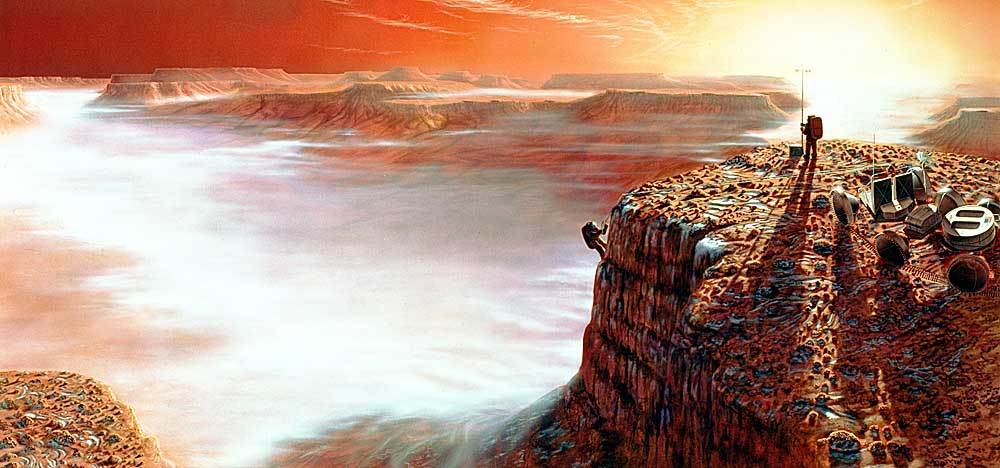Settling on Mars

Martian settlers on a weekend excursion. Painting by Pat Rawlings, courtesy NASA.
At the September 27, 2016 meeting of the International Astronautical Congress in Guadalajara, Mexico, Elon Musk, CEO of Space X, first announced his bold plan to build a city on Mars. According to Mark Hopkins, economist and Chair of the Executive Committee of the National Space Society and who was present at the talk, “The vast majority of the resources of our solar system lie in space rather than on the Earth. By settling Mars and other locations in space we can overcome the resource limits of Earth leading to a hopeful, prosperous future for all of humanity.”
During the talk Musk detailed what he called the Interplanetary Transport System (ITS). The first stage of the ITS towers 77.5 meters with a diameter of 12 meters and uses 42 Raptor engines to provide a total of 28 million lbs of thrust. The second stage is 49.5 meters long, 17 m in diameter, uses 9 Raptor engines, and comes in both a crew/cargo model and a tanker model. Musk’s plans are based on four key approaches: full reusability of all components, refueling in orbit around Earth, refueling on Mars with locally produced propellant, and using a rocket fuel (methane/oxygen) that can be manufactured on Mars. Musk envisions that the eventual cost of a ticket to Mars will be in the $100K-$200K U.S. dollars range, allowing ordinary people to eventually travel to Mars.
Musk’s entire historic 2016 talk can be found here.
On September 29th, 2017, at the International Astronautical Congress in Adelaide, Australia, Musk provided an update to his 2016 presentation regarding the long-term technical challenges that need to be solved to support the creation of a permanent, self-sustaining human presence on Mars. This entire 43-minute presentation is provided below:
Musk’s plan is in many ways an update of the original “Mars Direct” plan of Robert Zubrin.
At the National Space Society International Space Development Conference in Anaheim, California, on April 20, 1990, Robert Zubrin brought down the house with the first public presentation of the “Mars Direct” scenario developed by Zubrin and his colleague David Baker of the Martin Marietta company. The Mars Direct scenario held potential of lowering costs and of bringing the human exploration and settlement of the Red Planet into the realm of feasibility.
The Mars Direct scenario lowered cost in two key ways: (1) by extensively relying whenever possible on in situ (on site) resource utilization (ISRU), such as the automated manufacture of return fuel from the Martian atmosphere before the first humans even leave for Mars; and (2) by launching directly from Earth, making it unnecessary to first develop an infrastructure in Earth orbit or on the Moon (the hardware developed for Mars Direct could also be used on the Moon, however). [Musk updated this by using reusable rockets and spacecraft.]
Zubrin describes his ideas quite effectively in the following three articles he wrote for the NSS magazine, Ad Astra:
The Significance of the Martian Frontier
Recommended Reading
1996: The Case for Mars: the Plan to Settle the Red Planet and Why We Must, by Robert Zubrin with Richard Wagner. The Free Press. Carl Sagan wrote: “Bob Zubrin really, nearly alone, changed our thinking on this issue.” [Review] [Buy from Amazon
2003: A Traveler’s Guide to Mars: The Mysterious Landscapes of the Red Planet, by William K. Hartmann. Workman Publishing. Kim Stanley Robinson called this book “a masterpiece of scientific writing for the general reader.” We agree. Profusely illustrated. [Review] [Buy from Amazon]
Mars Library
2011: Access to Mars, by John K. Strickland, Jr. Presentation at the International Space Development Conference, Huntsville, Alabama, May 18-22, 2011. 109 pages. [PDF 3.1 MB]
2009: Human Exploration of Mars Design Reference Architecture 5.0. NASA-SP-2009-566. 100 pages. [PDF 3.8 MB]. Addendum, NASA-SP-2009-566-ADD, 406 pages. [PDF 33 MB]
2006: Assessment of NASA’s Mars Architecture 2007-2016. National Academy of Sciences. 62 pages. [PDF 371K]
2003: Space Colonization Using Space-Elevators from Phobos, by Leonard M. Weinstein, NASA Langley Research Center. 9 pages. [PDF 180K]
2002: Safe on Mars: Precursor Measurements Necessary to Support Human Operations on the Martian Surface. National Academy of Sciences. 64 pages.
2001: The Mars Surface Reference Mission: A
Description of Human and Robotic Surface Activities, by Stephen J. Hoffman. NASA/TP—2001–209371. 114 pages. [PDF 1.3 MB]
2001: Humans to Mars: Fifty Years of Mission Planning, 1950-2000, by David S. F. Portree. NASA SP-2001-4521. 151 pages. [PDF 2.4 MB]
1998: Resource Utilization and Site Selection for a Self-Sufficient Martian Outpost. NASA/TM-98-206538. 54 pages. [PDF 6.4 MB]
1997: Human Exploration of Mars: The Reference Mission of the NASA Mars Exploration Team. NASA Special Publication 6107. 237 pages. [PDF 2.3 MB] This Reference Mission was heavily influenced by the Mars Direct scenario and has been called “Mars Semi-Direct.”
1993: Resources of Near-Earth Space, Part IV: Mars. University of Arizona Press.






